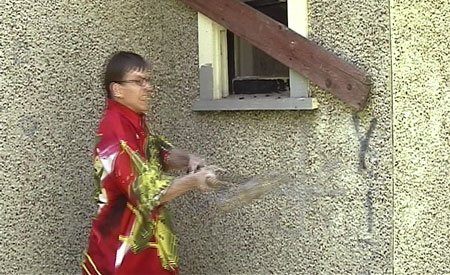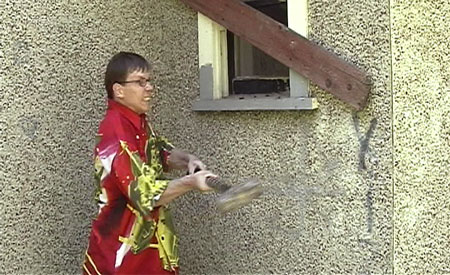
Why might I need a HD Camera?
In 2003, JVC released the GR-HD1 in the US. A prosumer HDTV video camera.
I recently picked up one second hand off eBay for $1700 USD. JVC still lists suggested retail price as $3500 USD, thou I don’t expect many are still selling at that price.
My opinions come from strictly DV experience. I’m not a film guy stepping down to HDTV, I’m a DV guy stepping up.
Anamorphic DV – A Beginner’s Guide to HD.
Lets take a close look at DV footage before looking at HD. NTSC DV footage is recorded at 720×480. This can either be 4:3 or, with modern DV cameras 16:9 (anamorphic).
Now why would you shoot at 16:9? Aside from artistic reasons, it has the potential to look sharper on an when played back on a high definition television.
Good old fashioned NTSC video, as found on Beta, VHS, Laserdiscs and old DVDs has crappy vertical resolution. Only 480 pixels. As we advanced from old tape formats like VHS up to DVDs in the 1990s, horizontal resolution steadily improved as analog then digital formats could record more detailed picture information.
But the 480 vertical lines were unfortunately “hard coded” into the NTSC video format. To change this number would have been to redefine what the NTSC standard of television was, and the new format would be incompatible with all existing television sets (such as HDTV is).
As the public demand for letterboxed movies grew, these 480 lines began to look more and more meager. To show a pan-and-scanned movie (or a movie shot with an aspect ratio of 4:3 such as Citizen Kane), all 480 lines could be utilized. But a movie recorded with an aspect ratio of 16:9 had a vertical resolution of only 360 pixels. And a CinemaScope movie (shot at 2.35:1) such as Star Wars had a vertical resolution of only 272 pixels. This is why videophiles in the late 80s were often found sobbing on street corners.
Televisions got bigger and bigger, the picture looked crappier and crappier. Until HDTV was introduced offering 16:9 aspect ratio and a vertical resolution of (at least) 720 pixels. This opened up an opportunity for DVD manufacturers.
Starting in 1999, “anamorphic” DVDs began appearing. Instead of using only 360 vertical pixels to describe a 16:9 movie, these discs vertically stretched the picture so that all 480 lines were used. A normal DVD player would re-squish the 480 pixels down to 360, resulting in a picture quality similar to the old letterboxed DVDs. No improvement.
But a progressive scan DVD player took this 25% improvement in vertical resolution, and used it to construct an HD signal of 720 vertical pixels. Thru image processing progressive scan DVD players could try improve the picture further as they increased the vertical resolution, but the core improvement was the 25% increase in picture data.
Buying a DV camera, and shooting at 16:9 gives you the EXACT SAME 25% improvement in picture quality. You can author an anamorphic DVD, and your progressive scan DVD player will extrapolate the 720×480 frames into 1280×720 signal for your HDTV. Of course just because the signal is 1280×720 doesn’t mean the picture is that detailed. Like converting photo scanned at low resolution to a higher resolution with Photoshop, an increase in file size does not mean a corresponding increase in picture quality.
“Yes, yes!” you scream, “Enough about the bloody Anamorphic DV! I ain’t here for a 25% improvement in picture quality! I want the whole enchilada. 1280×720 resolution. And fresh sushi served on a naked virgin.”
Well my rant about anamorphic DV was to illustrate the typical mechanism for playing back anamorphic DV footage: authoring an anamorphic DVD. An anamorphic DVD is a PERFECT way to store anamorphic DV footage, and share it with your friends whether or not they own an HDTV.
The problem with HD cameras is, there is no such convenient way to share your HD masterpiece.
You can hook your HD camera up to your HDTV (or HD projector), and it looks fantastic. Or play it back on your computer (you’ll need lots of CPU power, my 2.6 GHz machine chugs). But if you’re intending to share your HD home movie with all your HDTV owning friends, your options are limited.
There is simply no standard “HD” format for DVDs right now. Nothing beyond the anamorphic DVD standard which only gives you a 25% improvement in picture quality over normal DVDs.
The best scenario I can come up with, is you burn a DVD-R with the HD MPEG2 data file on it, and your friends play that back on their computer. If they have an HD-video-out card they can feed that signal to their HDTV. This presumes a lot of non-typical equipment, AND a fast computer to play the HD MPEG-2 file smoothly.
No doubt, in the near future we’ll be seeing an HD-DVD spec, HD-DVD burners to create the HD video discs and copies of Basic Instinct on HD-DVD for only $9.95. But RIGHT NOW, your best bet might just be a $400 miniDV camera recording anamorphic video. That’s $1800 you can put towards an HD video camera once all the consumer watching/sharing kinks are worked out. And you know they’ll be cheaper then.
Why might I need an HD camera?
Don’t coil a turd on that HD video camera just yet! Oh all that talk about “you can’t author an HD DVD?” That was just to scare off the masses. Shhh… wait… yeah. They’re gone. Now we can talk.
Slow motion. Blue screen. Special effects. Wire removal. Not typically needed for home movies. But if you’re looking to produce corporate videos, or implement just about any sort of special effect, HD can help immensely.
Lets start with color. No matter how good your DV camera is, even if it is a 3-chip model, you are constrained by the DV format’s low bitrate dedicated to color information. If you zoom in on a single frame of colorful DV footage, you’ll see that the color data is at a much lower resolution then the luminance data. When the DV codec was being developed, they took advantage of the fact that people do not perceive color at as high a resolution as we do luminance.
So watching a DV clip, you won’t likely notice this loss of color information. But when a blue screen effect is used on DV footage, the edge of the effect will appear pixilated and… craptastic. Today’s blue screen effects often try compensate specifically for DV’s lower color resolution, but you can never fully make up for lost data, and a choice will be made between a pixilated edge, or a blurry one.
Aside from blue screens, the extra (or at least adequate) color information stored in HD footage lets you up the saturation. This is common for commercials and music videos. But doing so with DV footage screams out, “my color data was recorded at quarter resolution!”
DV shoots at 720x480x60i (i=interlaced). JVC GR-HD1 at 1280x720x30p (p=progressive). A progressive frame is a normal frame. 1280 pixels across, 720 pixels down. An interlaced frame is the separation of odd and even lines, so that first the odd lines are displayed, then the even lines.
In the 1920s when television technology was in its infancy, it was difficult to transmit and display an entire frame 60 times a second. A picture could be transmitted 30 times a second, but the human eye detected this as an annoying flickering. So a solution was to alternate the odd/even lines as the picture was being redrawn so only 1/2 the frame was transmitted and displayed every 60th of a second. Television footage is perceived as extremely smooth because of this.
Unfortunately, it is also perceived as extremely crappy by anyone trying to work with a single frame of DV footage.

Interlaced Frame
Trying to perform special effects (say wire removal) on an interlaced frame is all but impossible, so NTSC footage is often interpreted as 720×240 frames 60 times a second.

Low Resolution Frame
Not so bad for wire removal. Hell if you’re trying to track movement, or zoom in on something (re-crop the shot) in post production.
It might be possible to find a DV camera that can record 720x480x30p. Oh look, here’s one: Sony DCR-TRV110. Too bad the footage looks like shit. Its not really capturing 30p, its simply taking one field of 60p and replicating it. To truly capture 30p, a DV camera needs a CCD designed specifically with that feature in mind, instead of an effect mode they should call “suck”.
Aside from shooting in 1280x720x30p, the JVC GR-HD1 also offers 720x480x60p recording. That’s 60 FULL FRAMES a second. If you have any desire to try slow motion videography, this is what you’re looking for. Playing back the footage at half speed is flawless.
And the least exciting feature of capturing footage in HD is the ability to re-crop shots. Any shot you’ve framed too wide can be re-cropped. Such a seemingly harmless effect has a disastrous impact on quality when applied to DV footage.
Say there is a boom mike poking in the top of a shot, recorded on DV footage. You only need to remove 18 pixels off the top to hide it. So you might think… 16:9 aspect ratio… lets enlarge the shot in post production so that the top 18 pixels are cut off… and lets take 8 off the left and 8 off the right. No one will be the wiser except… OH MY GOD THAT LOOKS TERRIBLE! JESUS, SWEET JESUS WHAT HAVE I DONE? You stupid fool. Interlaced footage can’t be “re-cropped”. The odd lines contain video information that occurred 1/60th of a second before the video information in the even lines. By re-cropping the shot, you’re mixing the contents of 2 consecutive frames.
Such post-production re-cropping is error-free when HD is your source. In fact, if the final destination for your video is an anamorphic DVD, you can tighten your shots by about 40% before pixilation becomes noticeable. If you wanted to, a shot of 2 people (say Billy and Bob) talking across a table could serve as raw footage for 3 different compositions.
- Billy and Bob sitting across the table from each other.
- Tight shot on Billy.
- Tight shot on Bob.
And what about making a movie? You know? For the theatres? James Cameron, George Lucas, Robert Rodriguez and now Steven Spielberg are shooting digital. Does this put me in the same boat?
Rodriguez owns (at least) 2 Sony HDW-F900 cameras. They’re worth $100,000 USD each. Records at 1920x1080x24p (or 30p).
I can’t imagine anyone declaring 720 vs 1080 vertical lines of resolution any sort of barrier to showing a movie in a theatre. Hell, I’m confident you could record a movie with 480 vertical lines of resolution and get it shown in the theatres. So long as the footage is progressive and not interlaced, it’ll look better then Blair Witch.
In my opinion, the biggest difference is that Rodriguez uses the HDW-F900 to shoot at 24 frames/second, but the GR-HD1 shoots HD at 30 frames/second. Film is projected at 24 frames/second.
What is your end medium? If its film, then this simply isn’t the HD camera for you. Thou a 24p camera will certainly run you more then $1700 USD right now, prices will fall, and no doubt one will eventually be available that fits your budget.
But if your goal is producing a anamorphic DVD (or an HD-DVD when there is such a thing), or even aiming for digital projection of your video in a theatre, 30p is not a barrier. There is nothing inherently good about 24p, just that its an established standard for film speed. And you can certainly take 30p footage, and blend the appropriate frames to achieve 24p. I would argue that 30p vs 24p is actually a choice between which medium you want your video to look best in. If it is film projected in a theatre (which, admittedly has the overall capability of looking the best), then you want to shoot 24p.
But say you’re planning on shooting an indie movie. Likely, most people will be seeing your movie on DVD, and some of those people will be playing it back on HDTV sets. By recording at 24p you are actually degrading their viewing experience. We’ve all come to expect this, as all the movies we watch on DVD were shot 24p (usually on film, now occasionally on video). This is part of the distinctive “film look” of movies. They have a very low frame rate which is how people can immediately tell the difference between video footage and movie footage. Shooting at 30p can be a happy medium between the two. Interlaced footage (60i) screams out “video!” and 24p screams out “movie!”… 30p still says movie, but without the blended, unclear frames resulting from the 24p to 60i conversion.
Make sure to checkout Gord’s review of the JVC GR-HD1 camera!

- Why might I need a HD Camera?
- by Gordon McDowell
- Published on July 1st, 2005
More from Gordon McDowell:
-

Comedy of Allyson Smith
The performance was hilarious each time, but also tuned to different levels of filthiness. Sadly, Allyson’s “It goes to eleven” moments can’t be represented on YouTube, lest the Internet’s pristine reputation become sullied.
-

How to Receive Both Infrared and Visible Light
As the little grey men walk across the scorched surface of our planet, I shall witness their approach… by monitoring the INFRARED SPECTRUM.
-

Calgary Hearts Dubya
The lecture circuit is an alluring mistress. She doesn’t care about your past deeds, only that you have fame. Success and failure are one in the same to her, so long as either is massive in scale.
-

Calgary’s Low Carbon Future
Calgary’s Low Carbon Future – Live coverage of keynote speakers. How will Calgary address the challenges of an economy being dragged kicking and screaming towards a lower carbon footprint?
-

Brownie points with Slumdog Millionaire
That's what your woman has really been craving every time she goes to see a chick flick, but she doesn't know it. In fact it is scientifically impossible for a woman NOT to watch the Slumdog Millionaire end credits and not feel deeply satisfied.
-

JVC GR-HD1 Review
I would suspect they are created during MPEG-2 compression, due to an insufficient bitrate. I can actually hear the camera change speed when playing back DV footage, compared to SD and HD footage.
Other recent features:
-

Sónar 2010 – Barcelona, Spain
The festival attracts a lot of outsiders, but the Mediterranean, Spanish and more specifically Catalan nature of the people makes the festival what it is. Catalan people are passionate and this passion is infectious. The atmosphere is electric in Barcelona as a city and heightened by music and intoxicants at Sónar.
-

Summer Party Naval Styles at Seven RestoLounge
Oysters, like wine are affected by terroir and these Miyagi’s flavor profiles ranged with one showing a cleaner, almost tropical profile and the other being more salty, marine driven. As I was devouring the seemingly endless plates put in front of us, I sipped on a glass of fine sauvignon blanc.
-

R4NT Radio March 2010
R4NT Radio March 2010 um wow it’s been far too long since the last edition edition, featuring: Hector Hernandez, The Infesticons, Blockhead, Gramatik, Emika, Thunderheist, Parov Stelar, Eddy Meets Yannah, Anti-Pop Consortium, The Slew, Lighterthief, Andreya Triana, Parasyte Woman, Mathon, Venetian Snares, and Funki Porcini.
-

O Restaurant & Lounge revisited
Calgary has a diverse set of urban communities, most of which have the ubiquitous strip mall watering hole. In the South West community of Marda Loop, a reinvention of this paradigm has been established.
-

Predictions 2010.. and beyond!
So 2010 eh? Almost but not quite (no year zero they say) another decade? It seems like just yesterday that the world was waiting for Y2K. R4NT started publishing in March 2001, so we’re not quite 10 years old yet, but in internet years we are already a senior citizen.
-

Invictus
No matter what, the reality of Nelson Mandela is something that deserves screen time. Should this film even remotely intrigue the masses to take interest in this figure, the world would likely benefit greatly from it.

